Business Decision Making Report: X Plc. Investment Strategy Analysis
VerifiedAdded on 2023/01/16
|8
|1814
|38
Report
AI Summary
This report examines business decision-making processes, focusing on investment appraisal techniques used by X Plc. The introduction highlights the importance of informed decisions for achieving benefits like increased productivity and efficient resource utilization. The main body delves into t...

Business Decision Making
Paraphrase This Document
Need a fresh take? Get an instant paraphrase of this document with our AI Paraphraser

Table of Contents
INTRODUCTION...........................................................................................................................1
MAIN BODY...................................................................................................................................1
CONCLUSION................................................................................................................................4
REFERENCES................................................................................................................................5
.........................................................................................................................................................5
INTRODUCTION...........................................................................................................................1
MAIN BODY...................................................................................................................................1
CONCLUSION................................................................................................................................4
REFERENCES................................................................................................................................5
.........................................................................................................................................................5
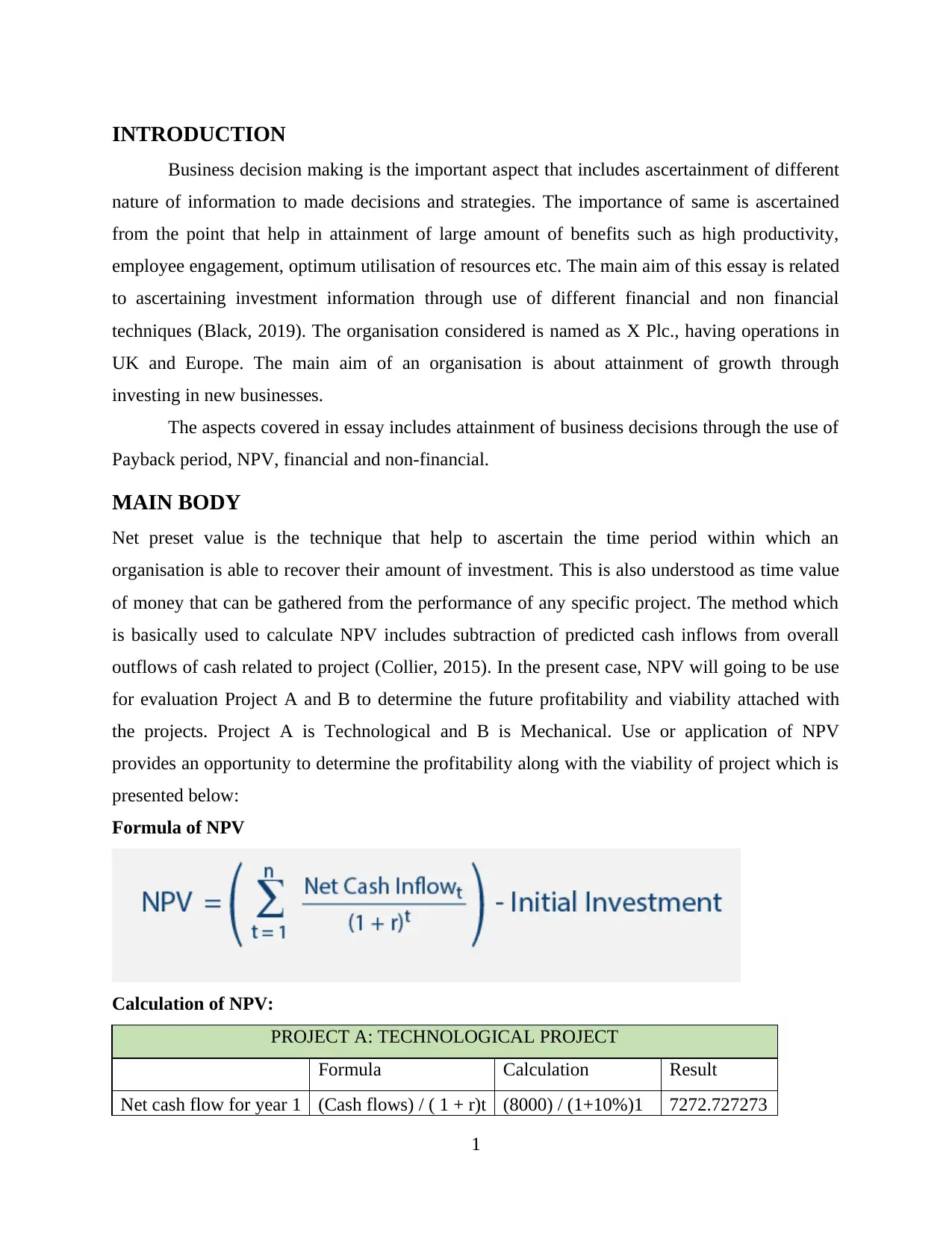
INTRODUCTION
Business decision making is the important aspect that includes ascertainment of different
nature of information to made decisions and strategies. The importance of same is ascertained
from the point that help in attainment of large amount of benefits such as high productivity,
employee engagement, optimum utilisation of resources etc. The main aim of this essay is related
to ascertaining investment information through use of different financial and non financial
techniques (Black, 2019). The organisation considered is named as X Plc., having operations in
UK and Europe. The main aim of an organisation is about attainment of growth through
investing in new businesses.
The aspects covered in essay includes attainment of business decisions through the use of
Payback period, NPV, financial and non-financial.
MAIN BODY
Net preset value is the technique that help to ascertain the time period within which an
organisation is able to recover their amount of investment. This is also understood as time value
of money that can be gathered from the performance of any specific project. The method which
is basically used to calculate NPV includes subtraction of predicted cash inflows from overall
outflows of cash related to project (Collier, 2015). In the present case, NPV will going to be use
for evaluation Project A and B to determine the future profitability and viability attached with
the projects. Project A is Technological and B is Mechanical. Use or application of NPV
provides an opportunity to determine the profitability along with the viability of project which is
presented below:
Formula of NPV
Calculation of NPV:
PROJECT A: TECHNOLOGICAL PROJECT
Formula Calculation Result
Net cash flow for year 1 (Cash flows) / ( 1 + r)t (8000) / (1+10%)1 7272.727273
1
Business decision making is the important aspect that includes ascertainment of different
nature of information to made decisions and strategies. The importance of same is ascertained
from the point that help in attainment of large amount of benefits such as high productivity,
employee engagement, optimum utilisation of resources etc. The main aim of this essay is related
to ascertaining investment information through use of different financial and non financial
techniques (Black, 2019). The organisation considered is named as X Plc., having operations in
UK and Europe. The main aim of an organisation is about attainment of growth through
investing in new businesses.
The aspects covered in essay includes attainment of business decisions through the use of
Payback period, NPV, financial and non-financial.
MAIN BODY
Net preset value is the technique that help to ascertain the time period within which an
organisation is able to recover their amount of investment. This is also understood as time value
of money that can be gathered from the performance of any specific project. The method which
is basically used to calculate NPV includes subtraction of predicted cash inflows from overall
outflows of cash related to project (Collier, 2015). In the present case, NPV will going to be use
for evaluation Project A and B to determine the future profitability and viability attached with
the projects. Project A is Technological and B is Mechanical. Use or application of NPV
provides an opportunity to determine the profitability along with the viability of project which is
presented below:
Formula of NPV
Calculation of NPV:
PROJECT A: TECHNOLOGICAL PROJECT
Formula Calculation Result
Net cash flow for year 1 (Cash flows) / ( 1 + r)t (8000) / (1+10%)1 7272.727273
1
⊘ This is a preview!⊘
Do you want full access?
Subscribe today to unlock all pages.

Trusted by 1+ million students worldwide
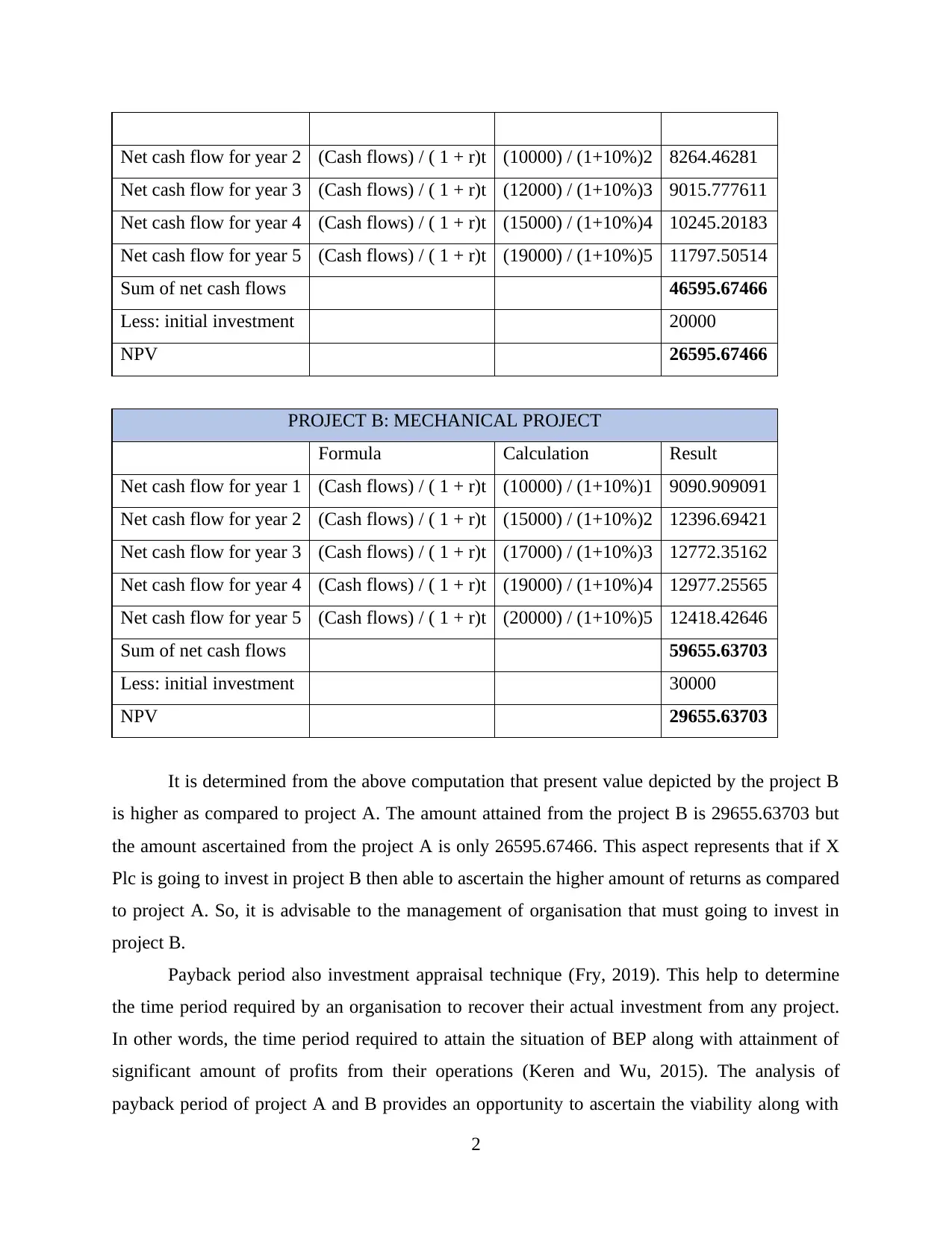
Net cash flow for year 2 (Cash flows) / ( 1 + r)t (10000) / (1+10%)2 8264.46281
Net cash flow for year 3 (Cash flows) / ( 1 + r)t (12000) / (1+10%)3 9015.777611
Net cash flow for year 4 (Cash flows) / ( 1 + r)t (15000) / (1+10%)4 10245.20183
Net cash flow for year 5 (Cash flows) / ( 1 + r)t (19000) / (1+10%)5 11797.50514
Sum of net cash flows 46595.67466
Less: initial investment 20000
NPV 26595.67466
PROJECT B: MECHANICAL PROJECT
Formula Calculation Result
Net cash flow for year 1 (Cash flows) / ( 1 + r)t (10000) / (1+10%)1 9090.909091
Net cash flow for year 2 (Cash flows) / ( 1 + r)t (15000) / (1+10%)2 12396.69421
Net cash flow for year 3 (Cash flows) / ( 1 + r)t (17000) / (1+10%)3 12772.35162
Net cash flow for year 4 (Cash flows) / ( 1 + r)t (19000) / (1+10%)4 12977.25565
Net cash flow for year 5 (Cash flows) / ( 1 + r)t (20000) / (1+10%)5 12418.42646
Sum of net cash flows 59655.63703
Less: initial investment 30000
NPV 29655.63703
It is determined from the above computation that present value depicted by the project B
is higher as compared to project A. The amount attained from the project B is 29655.63703 but
the amount ascertained from the project A is only 26595.67466. This aspect represents that if X
Plc is going to invest in project B then able to ascertain the higher amount of returns as compared
to project A. So, it is advisable to the management of organisation that must going to invest in
project B.
Payback period also investment appraisal technique (Fry, 2019). This help to determine
the time period required by an organisation to recover their actual investment from any project.
In other words, the time period required to attain the situation of BEP along with attainment of
significant amount of profits from their operations (Keren and Wu, 2015). The analysis of
payback period of project A and B provides an opportunity to ascertain the viability along with
2
Net cash flow for year 3 (Cash flows) / ( 1 + r)t (12000) / (1+10%)3 9015.777611
Net cash flow for year 4 (Cash flows) / ( 1 + r)t (15000) / (1+10%)4 10245.20183
Net cash flow for year 5 (Cash flows) / ( 1 + r)t (19000) / (1+10%)5 11797.50514
Sum of net cash flows 46595.67466
Less: initial investment 20000
NPV 26595.67466
PROJECT B: MECHANICAL PROJECT
Formula Calculation Result
Net cash flow for year 1 (Cash flows) / ( 1 + r)t (10000) / (1+10%)1 9090.909091
Net cash flow for year 2 (Cash flows) / ( 1 + r)t (15000) / (1+10%)2 12396.69421
Net cash flow for year 3 (Cash flows) / ( 1 + r)t (17000) / (1+10%)3 12772.35162
Net cash flow for year 4 (Cash flows) / ( 1 + r)t (19000) / (1+10%)4 12977.25565
Net cash flow for year 5 (Cash flows) / ( 1 + r)t (20000) / (1+10%)5 12418.42646
Sum of net cash flows 59655.63703
Less: initial investment 30000
NPV 29655.63703
It is determined from the above computation that present value depicted by the project B
is higher as compared to project A. The amount attained from the project B is 29655.63703 but
the amount ascertained from the project A is only 26595.67466. This aspect represents that if X
Plc is going to invest in project B then able to ascertain the higher amount of returns as compared
to project A. So, it is advisable to the management of organisation that must going to invest in
project B.
Payback period also investment appraisal technique (Fry, 2019). This help to determine
the time period required by an organisation to recover their actual investment from any project.
In other words, the time period required to attain the situation of BEP along with attainment of
significant amount of profits from their operations (Keren and Wu, 2015). The analysis of
payback period of project A and B provides an opportunity to ascertain the viability along with
2
Paraphrase This Document
Need a fresh take? Get an instant paraphrase of this document with our AI Paraphraser
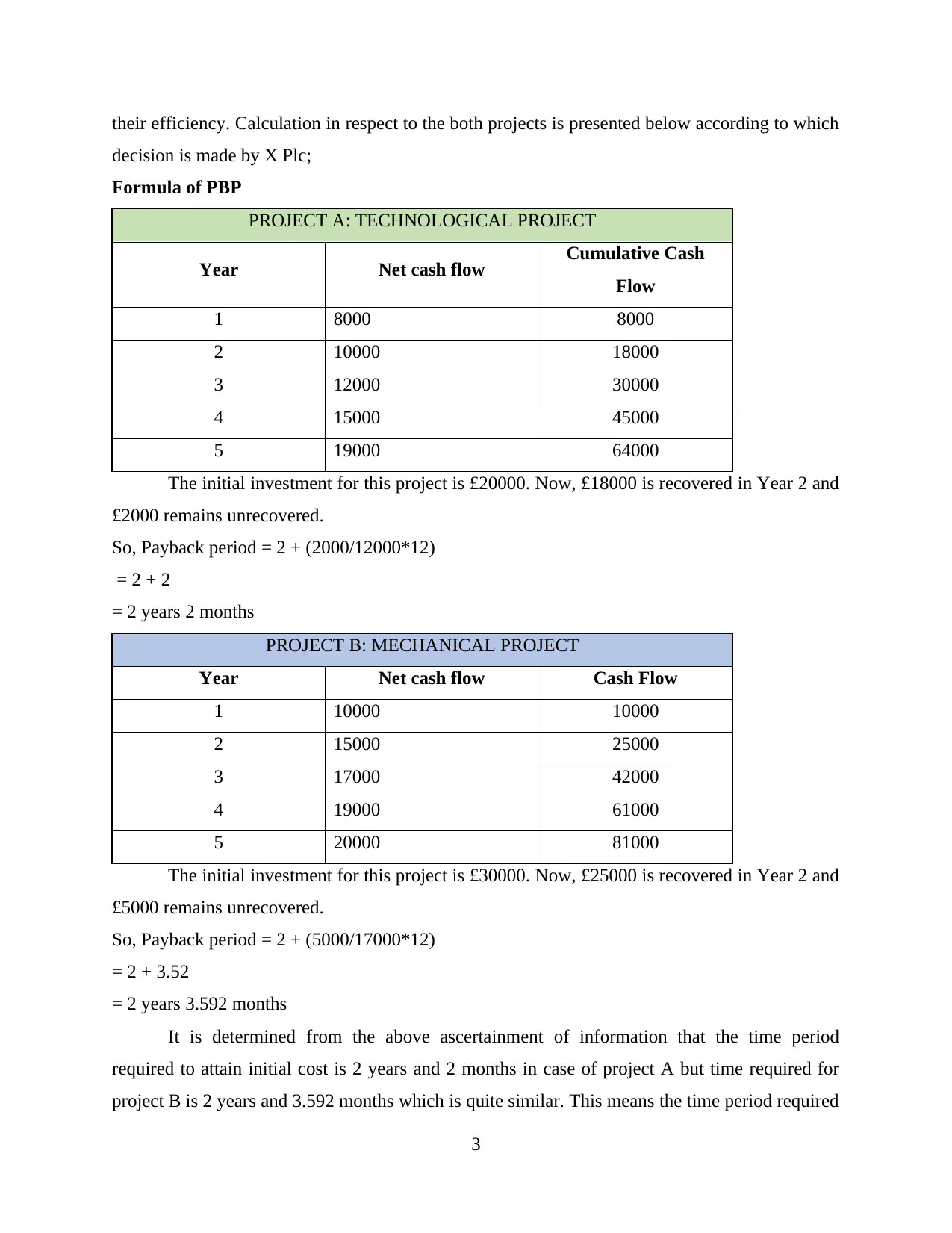
their efficiency. Calculation in respect to the both projects is presented below according to which
decision is made by X Plc;
Formula of PBP
PROJECT A: TECHNOLOGICAL PROJECT
Year Net cash flow Cumulative Cash
Flow
1 8000 8000
2 10000 18000
3 12000 30000
4 15000 45000
5 19000 64000
The initial investment for this project is £20000. Now, £18000 is recovered in Year 2 and
£2000 remains unrecovered.
So, Payback period = 2 + (2000/12000*12)
= 2 + 2
= 2 years 2 months
PROJECT B: MECHANICAL PROJECT
Year Net cash flow Cash Flow
1 10000 10000
2 15000 25000
3 17000 42000
4 19000 61000
5 20000 81000
The initial investment for this project is £30000. Now, £25000 is recovered in Year 2 and
£5000 remains unrecovered.
So, Payback period = 2 + (5000/17000*12)
= 2 + 3.52
= 2 years 3.592 months
It is determined from the above ascertainment of information that the time period
required to attain initial cost is 2 years and 2 months in case of project A but time required for
project B is 2 years and 3.592 months which is quite similar. This means the time period required
3
decision is made by X Plc;
Formula of PBP
PROJECT A: TECHNOLOGICAL PROJECT
Year Net cash flow Cumulative Cash
Flow
1 8000 8000
2 10000 18000
3 12000 30000
4 15000 45000
5 19000 64000
The initial investment for this project is £20000. Now, £18000 is recovered in Year 2 and
£2000 remains unrecovered.
So, Payback period = 2 + (2000/12000*12)
= 2 + 2
= 2 years 2 months
PROJECT B: MECHANICAL PROJECT
Year Net cash flow Cash Flow
1 10000 10000
2 15000 25000
3 17000 42000
4 19000 61000
5 20000 81000
The initial investment for this project is £30000. Now, £25000 is recovered in Year 2 and
£5000 remains unrecovered.
So, Payback period = 2 + (5000/17000*12)
= 2 + 3.52
= 2 years 3.592 months
It is determined from the above ascertainment of information that the time period
required to attain initial cost is 2 years and 2 months in case of project A but time required for
project B is 2 years and 3.592 months which is quite similar. This means the time period required
3
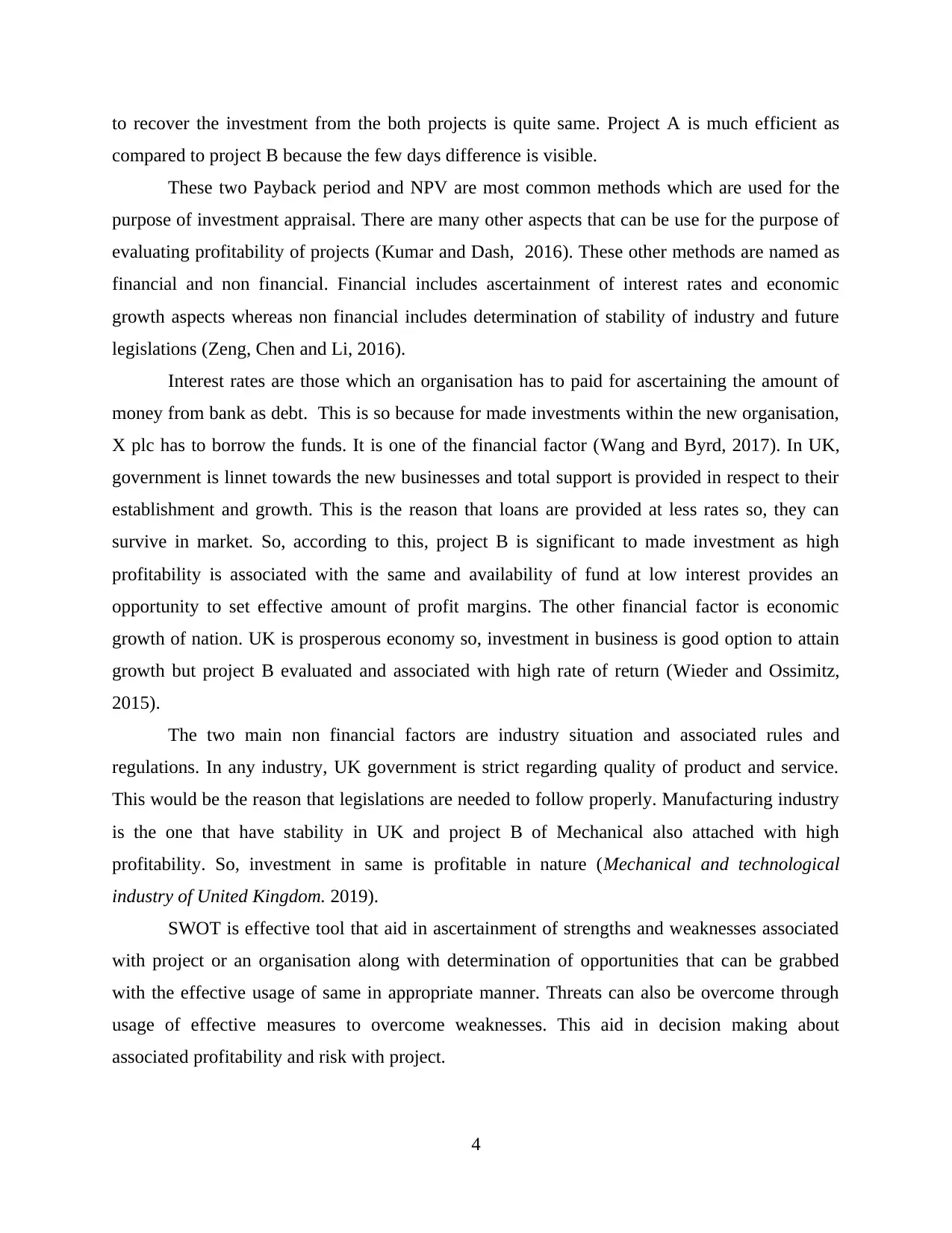
to recover the investment from the both projects is quite same. Project A is much efficient as
compared to project B because the few days difference is visible.
These two Payback period and NPV are most common methods which are used for the
purpose of investment appraisal. There are many other aspects that can be use for the purpose of
evaluating profitability of projects (Kumar and Dash, 2016). These other methods are named as
financial and non financial. Financial includes ascertainment of interest rates and economic
growth aspects whereas non financial includes determination of stability of industry and future
legislations (Zeng, Chen and Li, 2016).
Interest rates are those which an organisation has to paid for ascertaining the amount of
money from bank as debt. This is so because for made investments within the new organisation,
X plc has to borrow the funds. It is one of the financial factor (Wang and Byrd, 2017). In UK,
government is linnet towards the new businesses and total support is provided in respect to their
establishment and growth. This is the reason that loans are provided at less rates so, they can
survive in market. So, according to this, project B is significant to made investment as high
profitability is associated with the same and availability of fund at low interest provides an
opportunity to set effective amount of profit margins. The other financial factor is economic
growth of nation. UK is prosperous economy so, investment in business is good option to attain
growth but project B evaluated and associated with high rate of return (Wieder and Ossimitz,
2015).
The two main non financial factors are industry situation and associated rules and
regulations. In any industry, UK government is strict regarding quality of product and service.
This would be the reason that legislations are needed to follow properly. Manufacturing industry
is the one that have stability in UK and project B of Mechanical also attached with high
profitability. So, investment in same is profitable in nature (Mechanical and technological
industry of United Kingdom. 2019).
SWOT is effective tool that aid in ascertainment of strengths and weaknesses associated
with project or an organisation along with determination of opportunities that can be grabbed
with the effective usage of same in appropriate manner. Threats can also be overcome through
usage of effective measures to overcome weaknesses. This aid in decision making about
associated profitability and risk with project.
4
compared to project B because the few days difference is visible.
These two Payback period and NPV are most common methods which are used for the
purpose of investment appraisal. There are many other aspects that can be use for the purpose of
evaluating profitability of projects (Kumar and Dash, 2016). These other methods are named as
financial and non financial. Financial includes ascertainment of interest rates and economic
growth aspects whereas non financial includes determination of stability of industry and future
legislations (Zeng, Chen and Li, 2016).
Interest rates are those which an organisation has to paid for ascertaining the amount of
money from bank as debt. This is so because for made investments within the new organisation,
X plc has to borrow the funds. It is one of the financial factor (Wang and Byrd, 2017). In UK,
government is linnet towards the new businesses and total support is provided in respect to their
establishment and growth. This is the reason that loans are provided at less rates so, they can
survive in market. So, according to this, project B is significant to made investment as high
profitability is associated with the same and availability of fund at low interest provides an
opportunity to set effective amount of profit margins. The other financial factor is economic
growth of nation. UK is prosperous economy so, investment in business is good option to attain
growth but project B evaluated and associated with high rate of return (Wieder and Ossimitz,
2015).
The two main non financial factors are industry situation and associated rules and
regulations. In any industry, UK government is strict regarding quality of product and service.
This would be the reason that legislations are needed to follow properly. Manufacturing industry
is the one that have stability in UK and project B of Mechanical also attached with high
profitability. So, investment in same is profitable in nature (Mechanical and technological
industry of United Kingdom. 2019).
SWOT is effective tool that aid in ascertainment of strengths and weaknesses associated
with project or an organisation along with determination of opportunities that can be grabbed
with the effective usage of same in appropriate manner. Threats can also be overcome through
usage of effective measures to overcome weaknesses. This aid in decision making about
associated profitability and risk with project.
4
⊘ This is a preview!⊘
Do you want full access?
Subscribe today to unlock all pages.

Trusted by 1+ million students worldwide

PESTLE analysis is macro environment analysis that help to ascertain the impact of
external factors over project or an organisation. This help to identify the associated future
opportunities and threats. So, aid in decision-making about profitability of project along with
reduction of associated risks through adoption of proper measures.
CONCLUSION
It has been concluded from the above report that Pay back and NPV both are effective
techniques to ascertain the viability of project. For X Plc. Investment in project B is profitable as
compared to project A. Financial and non financial factors are also represents the favourable
result in relation to project B.
5
external factors over project or an organisation. This help to identify the associated future
opportunities and threats. So, aid in decision-making about profitability of project along with
reduction of associated risks through adoption of proper measures.
CONCLUSION
It has been concluded from the above report that Pay back and NPV both are effective
techniques to ascertain the viability of project. For X Plc. Investment in project B is profitable as
compared to project A. Financial and non financial factors are also represents the favourable
result in relation to project B.
5
Paraphrase This Document
Need a fresh take? Get an instant paraphrase of this document with our AI Paraphraser
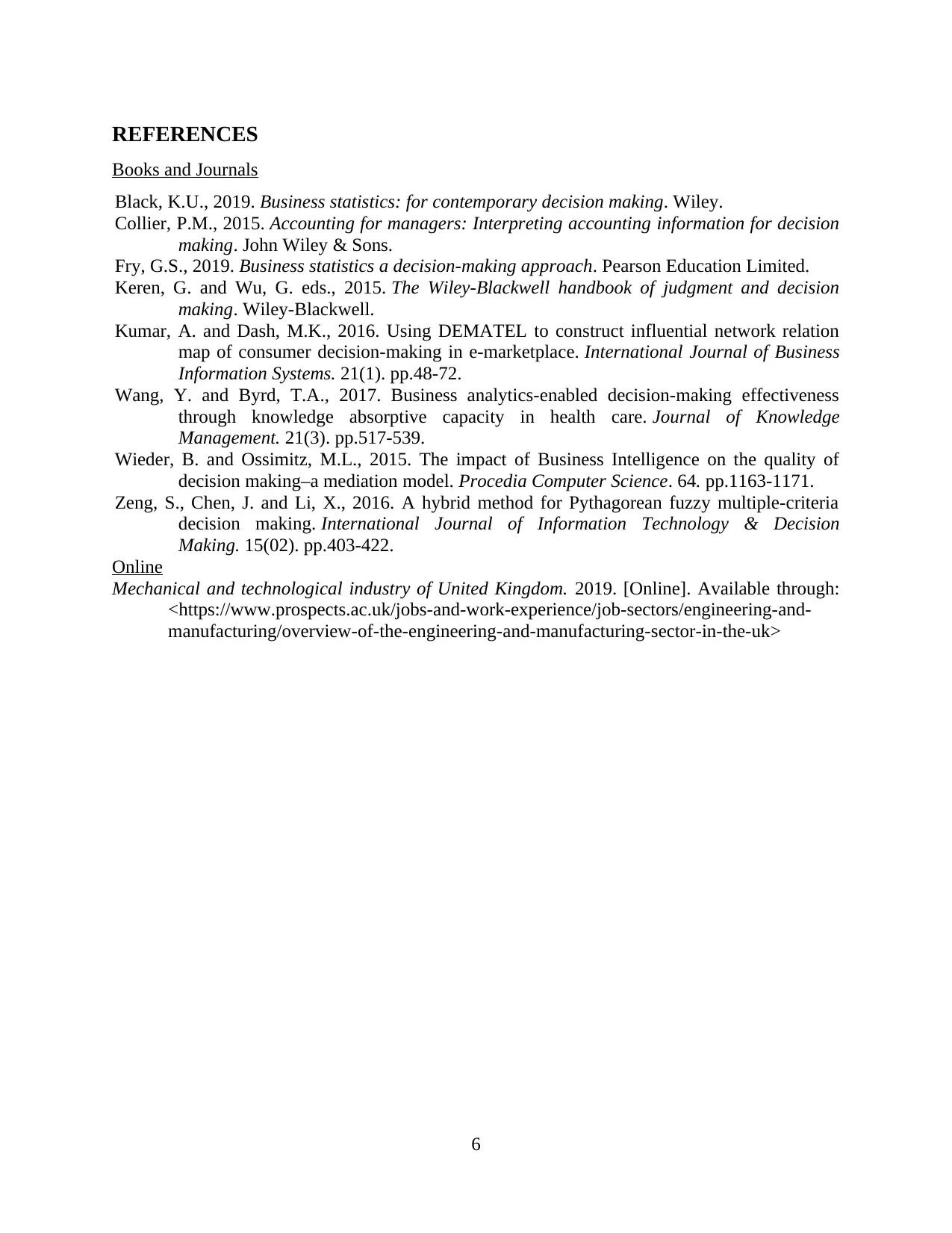
REFERENCES
Books and Journals
Black, K.U., 2019. Business statistics: for contemporary decision making. Wiley.
Collier, P.M., 2015. Accounting for managers: Interpreting accounting information for decision
making. John Wiley & Sons.
Fry, G.S., 2019. Business statistics a decision-making approach. Pearson Education Limited.
Keren, G. and Wu, G. eds., 2015. The Wiley-Blackwell handbook of judgment and decision
making. Wiley-Blackwell.
Kumar, A. and Dash, M.K., 2016. Using DEMATEL to construct influential network relation
map of consumer decision-making in e-marketplace. International Journal of Business
Information Systems. 21(1). pp.48-72.
Wang, Y. and Byrd, T.A., 2017. Business analytics-enabled decision-making effectiveness
through knowledge absorptive capacity in health care. Journal of Knowledge
Management. 21(3). pp.517-539.
Wieder, B. and Ossimitz, M.L., 2015. The impact of Business Intelligence on the quality of
decision making–a mediation model. Procedia Computer Science. 64. pp.1163-1171.
Zeng, S., Chen, J. and Li, X., 2016. A hybrid method for Pythagorean fuzzy multiple-criteria
decision making. International Journal of Information Technology & Decision
Making. 15(02). pp.403-422.
Online
Mechanical and technological industry of United Kingdom. 2019. [Online]. Available through:
<https://www.prospects.ac.uk/jobs-and-work-experience/job-sectors/engineering-and-
manufacturing/overview-of-the-engineering-and-manufacturing-sector-in-the-uk>
6
Books and Journals
Black, K.U., 2019. Business statistics: for contemporary decision making. Wiley.
Collier, P.M., 2015. Accounting for managers: Interpreting accounting information for decision
making. John Wiley & Sons.
Fry, G.S., 2019. Business statistics a decision-making approach. Pearson Education Limited.
Keren, G. and Wu, G. eds., 2015. The Wiley-Blackwell handbook of judgment and decision
making. Wiley-Blackwell.
Kumar, A. and Dash, M.K., 2016. Using DEMATEL to construct influential network relation
map of consumer decision-making in e-marketplace. International Journal of Business
Information Systems. 21(1). pp.48-72.
Wang, Y. and Byrd, T.A., 2017. Business analytics-enabled decision-making effectiveness
through knowledge absorptive capacity in health care. Journal of Knowledge
Management. 21(3). pp.517-539.
Wieder, B. and Ossimitz, M.L., 2015. The impact of Business Intelligence on the quality of
decision making–a mediation model. Procedia Computer Science. 64. pp.1163-1171.
Zeng, S., Chen, J. and Li, X., 2016. A hybrid method for Pythagorean fuzzy multiple-criteria
decision making. International Journal of Information Technology & Decision
Making. 15(02). pp.403-422.
Online
Mechanical and technological industry of United Kingdom. 2019. [Online]. Available through:
<https://www.prospects.ac.uk/jobs-and-work-experience/job-sectors/engineering-and-
manufacturing/overview-of-the-engineering-and-manufacturing-sector-in-the-uk>
6
1 out of 8
Related Documents
Your All-in-One AI-Powered Toolkit for Academic Success.
+13062052269
info@desklib.com
Available 24*7 on WhatsApp / Email
![[object Object]](/_next/static/media/star-bottom.7253800d.svg)
Unlock your academic potential
© 2024 | Zucol Services PVT LTD | All rights reserved.





